Kelly Jensen's Blog, page 9
April 20, 2021
Mystery & Thriller Round-Up (Part I)
The past few weeks, I’ve mainly been reading mysteries and thrillers. Here are a few short reviews of some recent ones.
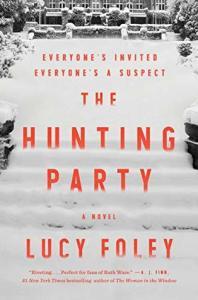 The Hunting Party and The Guest List by Lucy Foley
The Hunting Party and The Guest List by Lucy FoleyI’m happy to have learned about Lucy Foley, but sad that she only has two thrillers out so far. Both are solid suspense novels, the first set at a remote Scottish cabin during a New Year’s Eve party attended by a group of old college friends, and the second on an island during the wedding of a reality tv star and a social media influencer. Foley gives me some Ruth Ware vibes in her depictions of places and creation of interesting, complicated characters with secrets (though Ware remains my favorite current thriller writer). She’s especially good at plotting; everything a character reveals to the reader matters. I love a mystery novel that rewards that kind of close reading.
 One By One by Ruth Ware
One By One by Ruth WareThis is Ware’s take on Agatha Christie’s And Then There Were None, though only in the most basic plot sense: a group of people are murdered one by one in a remote location (in Ware’s case, a ski retreat attended by a tech start-up’s staff during a winter storm). Though more than one person does survive in Ware’s book, it’s not a whole lot more. This kind of storytelling helps the reader to narrow down the suspect list rather quickly! Ware is great at creating atmosphere, and while some readers have complained that she revealed the murderer too soon in the novel (it’s maybe an hour before the end, if you’re listening), I felt it happened at just the right point, and what followed was super suspenseful and completely riveting. With the exception of one character, Ware’s cast is maybe a bit more irritating in personality than those in her other books, but (unusually for a lot of thrillers), they do experience some personal growth, which was a nice surprise. And as is always the case in my favorite thrillers, the revelation of the murderer is only one of many secrets revealed throughout the course of the story.
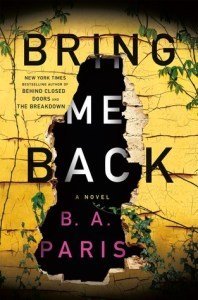 Bring Me Back by B. A. Paris
Bring Me Back by B. A. ParisI’ve read two of Paris’ other books – Behind Closed Doors and The Breakdown – and remember very little of either of them, even after re-reading their synopses and my very brief Goodreads reviews of each. I expect Bring Me Back won’t stick with me for very long either, though I did enjoy it. It’s about a man whose girlfriend Layla disappeared many years ago and was accused of her murder. When no body appeared – much less any other evidence – he was released, though the mark of suspicion has plagued him ever since. Since then, he and his girlfriend’s sister have gotten together, bonded by their mutual grief. But just after they get engaged, signs begin to appear that Layla isn’t dead at all – and she’s returned to plague her sister and former boyfriend.
I saw the end coming from a mile away here (perhaps because at this point I’ve read too many thrillers). The final resolution may rub some readers the wrong way, for reasons I won’t go into too much because of spoilers, but if you also are a frequent reader of thrillers like these, you probably know what many readers’ issue was. All the same, it’s not the worst example of the genre; nor is it the best.
March 30, 2021
A Couple of Unfinished Reads
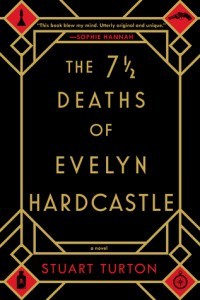 The 7 1/2 Deaths of Evelyn Hardcastle by Stuart Turton
The 7 1/2 Deaths of Evelyn Hardcastle by Stuart TurtonThe premise of this book – a historical mystery where one man relives each day in the body of a different person, with no memory of who he actually is, and must solve a murder before all of his “bodies” are expended – is fascinating. I love a good locked room mystery, which this one is, and I love it even more when it’s set in the past. The time repeating and body swapping conceits add interest, and Turton develops intriguing rules for both as the story progresses.
Unfortunately, the book fell short for me in two primary ways. First, the audiobook narrator simply cannot do female voices. This is a common pitfall for male narrators, and like many of his fellow men, narrator Jot Davies pitches the female characters’ voices unnaturally high and shrill in this book. Any sort of inflection indicating emotion or meaning is completely obscured to the point of not really even being attempted; the only feature of women’s voices as done by Davies is “high.” There’s only one main female character in the book, but as she’s the titular character and her relationships with the protagonist in all of his guises are of paramount importance, it makes for a very difficult listen.
Secondly, one of the people the protagonist inhabits is fat. Turton, through his protagonist, makes much mention of this fact. No one seems to much like this person when the protagonist isn’t controlling him, and his fatness seems to be the reason. Everyone around him (and within him) sees his fatness as a personal failure, something that goes hand in hand with – is both the cause and effect of – his laziness, rudeness, arrogance, and overall unlikability. This is no passing characterization; it’s brought up over and over, the protagonist’s disgust at inhabiting a fat body made apparent repeatedly. While I may have been able to get past the annoying female voicing, I stopped enjoying the book completely at this point and decided to give up.
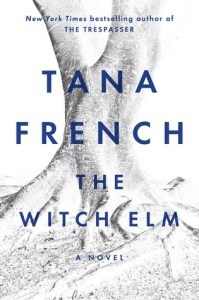 The Witch Elm by Tana French
The Witch Elm by Tana FrenchThis is a book that I think is actually objectively pretty good but I just didn’t particularly enjoy. It is S L O W. It took eight hours to get to the actual mystery; everything before that read like a slice of life novel about a generic Irish man named Toby who is not particularly likeable but also not particularly terrible either. He gets involved in an unethical thing at work, he’s in love with his girlfriend who is clearly too good for him, he argues about privilege with his friends at a bar, and he experiences a break-in at his home where he’s brutally beaten. He survives, but he has a long road to recovery ahead of him. After that, he decides to visit his dying uncle at the home he and his cousins visited during summers when they were kids, needing some time to get accustomed to the ways his life has changed after the attack and wanting to help care for a beloved family member in his final days. At this point, there were several more chapters of Toby caring for said uncle, reminiscing with him and his cousins, and so on. This could have been a novel about how a fairly self-centered man learns to care more about others in the wake of his own personal trials, and it would have been a good example of that – just not really what I was looking for.
Eight hours in, though, the mystery finally starts to show itself. One of his cousin’s kids discovers a skull in the old tree on the grounds (the witch elm of the title), and it turns out that it belongs to a classmate of Toby’s who disappeared when they were kids. Murder is clearly how he died – but who is the culprit? I listened for a bit longer, glad to have finally gotten to the good part (as I saw it), but the glacial pace continued and I stopped caring. Ultimately, I let my digital checkout expire, read the ending on Goodreads, and moved on.
March 18, 2021
This Week at Book Riot
Have I mentioned pregnancy is kicking my butt? I am officially 9 months pregnant and am pretty sure baby Jensen won’t be making it to her due date at this point (she’s already estimated at over 7 pounds!). But my hope is to get a bookish post up for next week since I am brimming with ideas!
In the mean time, here’s what I tackled at Book Riot this week:
An A to Z guide to literary devices.
A roundup of gorgeous pressed flower bookmarks.
March 16, 2021
The 9/11 Survivor Tree
This year is 20 years since 9/11. Being of an age to have watched this event unfold in real time, this “anniversary” is something I usually choose to ignore every year. Of course, children’s publishing (and publishing in general) loves anniversaries of things, so you can bet there are going to be a ton of picture books tied in some way to 9/11.
Funnily enough, though, the first few I’ve noticed are all about one very specific thing: the 9/11 “survivor tree,” a pear tree that survived the attacks (albeit with some permanent damage) and was replanted at the Memorial in 2010. You can read more about it here.
This is a gentle and hopeful way to introduce a really tough topic to small children, so it makes sense authors would choose it. But three seems like a lot. Two of them are even publishing the same month – May. Times like these I often find myself wondering if publishers ever talk to each other. Are three books on this very specific tree necessary? Maybe they are all genuinely good books. I don’t know.
I’m personally dreading the glut of books, social media, and other paraphernalia commemorating 20 years since the attack (it feels weird to call it an anniversary, like a bunch of people got married that day instead of murdered). We’re already dealing with half a million Americans dead from the pandemic, and being called to affirmatively “remember” an act of extreme violence that is etched on my entire generation’s consciousness sucks pretty hard. Sorry for the language, Mom – there’s no better way to put it.
When I buy books for the library, of course, my personal feelings don’t matter. So I’ll buy all the books about 9/11 that the community wants and needs, and I’m sure at least a few of them will do children a good service by teaching them about something that defined the world they were born into. But I won’t be reading any of them myself.
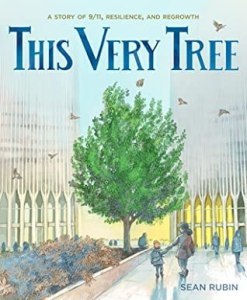 This Very Tree: A Story of Resilience, Community, and 9/11 by Sean Rubin (May 4)
This Very Tree: A Story of Resilience, Community, and 9/11 by Sean Rubin (May 4)In 1973, nestled between the newly completed Twin Towers in New York City, a Callery pear tree was planted. Over the years, the tree provided a home for birds and shade for people looking for a place to rest, along with the first blooms of spring.
On September 11, 2001, everything changed. The tree’s home was destroyed, and it was buried under the rubble. But a month after tragedy struck, a shocking discovery was made at Ground Zero: the tree had survived.
Dubbed the “Survivor Tree,” it was moved to the Bronx to recover. And in the thoughtful care of the New York City Department of Parks and Recreation, the Callery pear was nursed back to health. Almost a decade later, the Survivor Tree returned home and was planted in the 9/11 Memorial to provide beauty and comfort…and also hope.
This is the story of that tree–and of a nation in recovery. Told from the tree’s perspective, This Very Tree is a touching tribute to first responders, the resilience of America, and the restorative power of community.
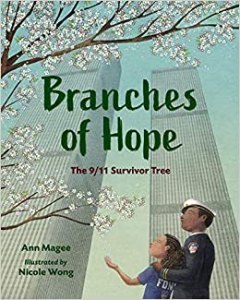 Branches of Hope: A Story About the 9/11 Survivor Tree by Ann Magee, illustrated by Nicole Wong (May 18)
Branches of Hope: A Story About the 9/11 Survivor Tree by Ann Magee, illustrated by Nicole Wong (May 18)The journey of the Callery pear tree rescued from Ground Zero and replanted ten years later is presented alongside a wordless story following a girl and her firefighter uncle who is a 9/11 hero.
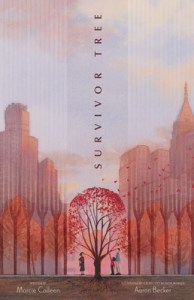 Survivor Tree by Marcie Colleen, illustrated by Aaron Becker (August 31)
Survivor Tree by Marcie Colleen, illustrated by Aaron Becker (August 31)One September day, the perfect blue sky exploded. Dust billowed. Buildings crumbled. And underneath it all, a tree sprouted green leaves in its distress. Pulled from the wreckage, the tree saw many seasons pass as it slowly recovered far away from home. Until one day, forever scarred and forever stronger, it was replanted at the 9/11 Memorial.
This story of the real Survivor Tree uses nature’s cycle of colors to reflect on the hope and healing that come after a tragedy — and assures readers of their own remarkable resilience.
March 11, 2021
This Week At Book Riot and Beyond
Over on Book Riot this week…
For the librarians out there, here’s your permission slip to weed racist books.These were the most uniquely popular books in US libraries from October to December last year.
Ideas for how to decorate with books.
And a sweet roundup of gifts for queer readers.
Elsewhere…
I was honored to write a guest post for Cynthia Leitich Smith’s Cynsations blog! I talked about why and how anthologies fill an important gap in youth collections.
I was quoted over on The Good Trade about how to read more books. Check it out.
March 4, 2021
This Week at Book Riot
It’s been quiet around here, but I’m hoping to knock out a few posts that have been sizzling in my mind this weekend. Thanks for continuing to hang around. I know both Kimberly and I appreciate it.
Here’s what I’ve been writing about over on Book Riot this week:
Spring 2021’s YA paperback releases.A look at YA authors who’ve just written romance novels.
Six Dr. Seuss books will cease publication.
A roundup of goods for readers who love books and cats.
You can also catch the latest episode of Hey YA, wherein Hannah and I dig into when, where, and why teens need to be exposed to “traumatic” topics in education, as well as awesome YA books about Black futures.
I’ve also got a piece over on School Library Journal this month exploring where and how tweens are involved in digital activism.
February 26, 2021
This Week at Book Riot
If you haven’t yet, I highly encourage reading Kimberly’s post from earlier this week. It was at once so familiar, so resonant, and also, as one commenter on Goodreads said, so cathartic. We’re all doing what we can with what we have but things are just . . . hard.
Here’s what I’ve written about over on Book Riot this week:
How to help with Texas’s recovery, literary style. This is a living document, so do feel free to pass along fitting projects via the information in the post.
Who Can Get Your Book? is an incredible new tool exploring accessibility of books in the digital age.
If you love typewriters, here’s a roundup of typewriter goods you can snag.
This research is so fascinating and, I think, something vital for anyone working with books and readers should think about: Black, Latinx, and Millennial readers are keeping the book industry afloat.
Last, but not least, YA books with 19-year-old characters.
And my last Hey YA Extra Credit before maternity leave is up, too: get to know this year’s YA Summer Scares picks.
February 23, 2021
This year has been a lot.
This is not really a book-related post.
If you’re a regular reader of Stacked (and if you are, thank you! At times I am not sure anyone reads book blogs anymore), you may have noticed that I haven’t written much here lately. This past twelve months my posts have often defaulted to book lists and short snippets of books I’m currently trying to read (books I usually don’t end up finishing). And in the past month or so, I’ve hardly blogged at all.
We’ve reached such a grim milestone with the pandemic – the United States has hit 500,000 deaths and we’re coming up on the one-year anniversary of my city largely shutting down. I know a lot of us will be taking stock of the ways our lives have changed in the past year. I remember a friend speculating in March 2020, when the focus was on “flattening the curve,” if the restaurants would be open and it would be safe enough for us to celebrate her birthday in May. There was some talk of taking bets on the question. Looking back on it now, that conversation seems laughable.
In the past year, I have taken no vacations and have traveled only once outside my immediate area, hopping a plane with an N-95 and a huge amount of trepidation in the fall to help take care of my grandmother for four days. Her 90th birthday celebration with her nearly 100-person family had been cancelled earlier in the year due to the pandemic. The year before the pandemic, I traveled to Michigan, Ireland, and Curacao, plus lots of trips across the huge and beautiful state of Texas. Since March 2020, I have been in to my work office a handful of times. I haven’t set foot inside a restaurant, something I used to do at least once a week. I have yet to meet my niece, who lives far away and will turn one year old soon. Sometimes these realities remind me of the joke I’ve seen across the internet – what are the people whose whole personality is to travel and go to restaurants going to do now that they can’t? Of course that’s not really my whole personality, but I’ve also found that I’m struggling to enjoy the other things I normally do that are pandemic-safe: reading, writing, running, playing video games. I worry how much the pandemic has affected me permanently.
And then there was last week. Texans often get some flak for our inability to withstand cold temperatures, but last week was beyond my imagination, both in terms of the weather and the failure of our infrastructure. It reached one degree Fahrenheit here (that’s -17 Celsius), and we received ice, topped with six inches of snow, topped with some more ice, over several days. As a result of a statewide failure to prioritize the health and safety of Texans by winterizing our power production and distribution systems, 4.5 million people in our state were without power and heat in their homes for up to five days. Many of those then lost water; all of us lost safe water and had to boil for days. People died.
Community members stepped up to help one another, including several of our stellar city councilmembers, and I’d like to say it was inspiring to witness, but it wasn’t really. It was just exhausting. And I’m one of the lucky ones – all my household endured was extreme conservation of energy, a boil water notice, and the constant, unending worry about everyone I know and love in Texas for a week straight. This last is something I have become accustomed to.
Recently, I found myself thinking about what a lie disaster movies are. I’ve had first-hand experience with two very different kinds of disasters recently, and the primary feeling during both is simply: boredom. There are no exciting action sequences featuring daring rescues or fiery showdowns with arch-villains responsible for the disasters. Instead, we just sit at home, many of us without even a job to occupy our time now, watching tv, scrolling twitter, worrying and waiting for the chance to see our loved ones again, to be safe again. Last week, lots of us didn’t even have the tv. For those with kids, the childcare routine has become all-consuming and stagnant at the same time, as this widely-read New York Times piece showed. The richness of life has faded.
What I miss most, at this moment, are the crowds. The appeal of a crowd is something I had only recently begun to appreciate before March 2020. A shy kid, I avoided them as a matter of course for much of my life. But a series of events a few years ago led me to venture out more; I met more people and tried more things and became more comfortable. And now a crowd is a shot of life: it’s the press of bodies at a concert, moving to the same music and mouthing the same words; it’s being with friends in a popular restaurant, picking up bits of interesting conversations at other tables in the midst of focusing on your own; it’s a standing room only comedy show where every time the person behind you laughs, you can feel a bit of their breath; it’s the glut of innertubes on an overcrowded river full of laughing people getting sunburned and a bit too drunk. It’s being able to see and hear and feel and belong with others. It’s knowing you’re part of the big human world and that you have a place in it, connected to everyone else.
The last time I felt that way was at Austin City Limits in October 2019. Lizzo was performing on a mid-sized stage, the planners having apparently missed the memo that she was huge now. I was lucky to get a pretty good spot to watch her perform, and she was fantastic. At times the crowd was so dense that it felt like my feet weren’t even on the ground. Everyone was dancing and screaming and jockeying for position. Everyone was in love. Moving through this crowd after the show ended to meet up with friends was almost impossible. In the midst of it, my phone was stolen, and it pretty much killed the rest of the night for me. But now, this moment feels like a privilege. I wonder how much longer it will be before an experience like this is safe again – but even more, I wonder how much longer before it will feel safe again.
I don’t have a whole lot of wisdom to share about a year of our lives gone to this. I just know that with each day we live like this, with each new disaster that piles on top of it, it feels less like a blip we must simply get through and more like something that is changing us. I think about how I’ll talk about this time to the next generation who didn’t live through it, whether they’ll be able to fully comprehend what it was like. That it was sameness, every day, with nothing new to distract us from the constant worry for our loved ones’ lives. I don’t know how quickly – or even if – I’ll feel like I’ve returned to normal at some point. I do know that I’ll be anticipating the next pandemic for the rest of my life, and that makes me feel old and sad. Perhaps these thoughts resonate with you too.
Above all, if you are reading this, I hope you are well, and safe, and warm. I hope you get to talk to the people you love. I hope you have maintained some connections or forged new ones. And I hope through this blog, you feel a connection with me.
February 18, 2021
This Week at Book Riot
Over on Book Riot this week…
Do you remember these children’s magazines from your youth? Take a walk down a nostalgic path and learn about the history of — and current iterations of — these beloved magazines.
A roundup of awesome gifts for audiobook lovers.
We can finally share the 2021 Summer Scares picks. I am in LOVE with the YA roster and proud to be part of this program.
There’s a new episode of Hey YA up this week, too. Dig into YA books with little or no romance, and then treat yourself to some great YA romance. Tune in here.
February 14, 2021
February 2021 Debut YA Novels
Wow are we in for a heck of a month of debut YA novels! When I started to pull February’s debuts together, I could not believe how many there were. Get excited for so many great new reads.
This round-up includes debut novels, where “debut” is in its purest definition. These are first-time books by first-time authors. I’m not including books by authors who are using or have used a pseudonym in the past or those who have written in other categories (adult, middle grade, etc.) in the past. Authors who have self-published are not included here either.
All descriptions are from Goodreads, unless otherwise noted. If I’m missing any debuts that came out or will come out in February from traditional publishers — and I should clarify that indie/small presses are okay — let me know in the comments.
As always, not all noted titles included here are necessarily endorsements for those titles. List is arranged alphabetically by title and publication month. Starred titles are the beginning of a new series.
February 2021 Debut YA Novels
 Amelia Unabridged by Ashley Schumacher
Amelia Unabridged by Ashley SchumacherEighteen-year-old Amelia Griffin is obsessed with the famous Orman Chronicles, written by the young and reclusive prodigy N. E. Endsley. They’re the books that brought her and her best friend Jenna together after Amelia’s father left and her family imploded. So when Amelia and Jenna get the opportunity to attend a book festival with Endsley in attendance, Amelia is ecstatic. It’s the perfect way to start off their last summer before college.
In a heartbeat, everything goes horribly wrong. When Jenna gets a chance to meet the author and Amelia doesn’t, the two have a blowout fight like they’ve never experienced. And before Amelia has a chance to mend things, Jenna is killed in a freak car accident. Grief-stricken, and without her best friend to guide her, Amelia questions everything she had planned for the future.
When a mysterious, rare edition of the Orman Chronicles arrives, Amelia is convinced that it somehow came from Jenna. Tracking the book to an obscure but enchanting bookstore in Michigan, Amelia is shocked to find herself face-to-face with the enigmatic and handsome N. E. Endsley himself, the reason for Amelia’s and Jenna’s fight and perhaps the clue to what Jenna wanted to tell her all along.
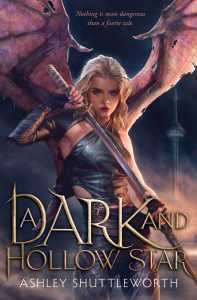 *A Dark and Hollow Star by Ashley Shuttleworth
*A Dark and Hollow Star by Ashley ShuttleworthChoose your player.
The “ironborn” half-fae outcast of her royal fae family.
A tempestuous Fury, exiled to earth from the Immortal Realm and hellbent on revenge.
A dutiful fae prince, determined to earn his place on the throne.
The prince’s brooding guardian, burdened with a terrible secret.
For centuries, the Eight Courts of Folk have lived among us, concealed by magic and bound by law to do no harm to humans. This arrangement has long kept peace in the Courts—until a series of gruesome and ritualistic murders rocks the city of Toronto and threatens to expose faeries to the human world.
Four queer teens, each who hold a key piece of the truth behind these murders, must form a tenuous alliance in their effort to track down the mysterious killer behind these crimes. If they fail, they risk the destruction of the faerie and human worlds alike. If that’s not bad enough, there’s a war brewing between the Mortal and Immortal Realms, and one of these teens is destined to tip the scales. The only question is: which way?
Wish them luck. They’re going to need it.
 Fat Chance, Charlie Vega by Crystal Maldonado
Fat Chance, Charlie Vega by Crystal MaldonadoCharlie Vega is a lot of things. Smart. Funny. Artistic. Ambitious. Fat.
People sometimes have a problem with that last one. Especially her mom. Charlie wants a good relationship with her body, but it’s hard, and her mom leaving a billion weight loss shakes on her dresser doesn’t help. The world and everyone in it have ideas about what she should look like: thinner, lighter, slimmer-faced, straighter-haired. Be smaller. Be whiter. Be quieter.
But there’s one person who’s always in Charlie’s corner: her best friend Amelia. Slim. Popular. Athletic. Totally dope. So when Charlie starts a tentative relationship with cute classmate Brian, the first worthwhile guy to notice her, everything is perfect until she learns one thing–he asked Amelia out first. So is she his second choice or what? Does he even really see her? UGHHH. Everything is now officially a MESS.
A sensitive, funny, and painful coming-of-age story with a wry voice and tons of chisme, Fat Chance, Charlie Vega tackles our relationships to our parents, our bodies, our cultures, and ourselves.
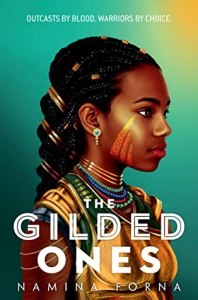 *The Gilded Ones by Namina Forna
*The Gilded Ones by Namina FornaSixteen-year-old Deka lives in fear and anticipation of the blood ceremony that will determine whether she will become a member of her village. Already different from everyone else because of her unnatural intuition, Deka prays for red blood so she can finally feel like she belongs.
But on the day of the ceremony, her blood runs gold, the color of impurity–and Deka knows she will face a consequence worse than death.
Then a mysterious woman comes to her with a choice: stay in the village and submit to her fate, or leave to fight for the emperor in an army of girls just like her. They are called alaki–near-immortals with rare gifts. And they are the only ones who can stop the empire’s greatest threat.
Knowing the dangers that lie ahead yet yearning for acceptance, Deka decides to leave the only life she’s ever known. But as she journeys to the capital to train for the biggest battle of her life, she will discover that the great walled city holds many surprises. Nothing and no one are quite what they seem to be–not even Deka herself.
 Hot British Boyfriend by Kristy Boyce
Hot British Boyfriend by Kristy BoyceAfter a horrifying public rejection by her crush, Ellie Nichols does what any girl would do: she flees the country. To be more precise, she joins her high school’s study abroad trip to England. While most of her classmates are there to take honors courses and pad their college applications, Ellie is on a quest to rebuild her reputation and self-confidence. And nothing is more of a confidence booster than getting a hot British boyfriend.
When Ellie meets Will, a gorgeous and charming Brit, she vows to avoid making the same mistakes as she did with the last guy she liked. Which is why she strikes up a bargain with Dev, an overachieving classmate who she’s never clicked with, but who does seem to know a lot about the things Will is interested in—if he helps her win over her crush, then she’ll help him win over his.
But even as Ellie embarks on a whirlwind romance, one that takes her on adventures to some of England’s most beautiful places, she still needs to figure out if this is actually the answer to all her problems…and whether the perfect boyfriend is actually the perfect boy for her.
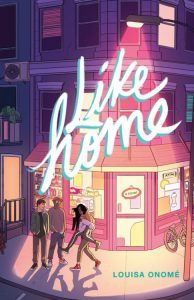 Like Home by Louisa OnoméChinelo, or Nelo as her best friend Kate calls her, is all about her neighborhood Ginger East. She loves its chill vibe, ride-or-die sense of community, and her memories of growing up there. Ginger East isn’t what it used to be, though. After a deadly incident at the local arcade, all her closest friends moved away, except for Kate. But as long as they have each other, Nelo’s good.
Like Home by Louisa OnoméChinelo, or Nelo as her best friend Kate calls her, is all about her neighborhood Ginger East. She loves its chill vibe, ride-or-die sense of community, and her memories of growing up there. Ginger East isn’t what it used to be, though. After a deadly incident at the local arcade, all her closest friends moved away, except for Kate. But as long as they have each other, Nelo’s good.Only, Kate’s parents’ corner store is vandalized, leaving Nelo shaken to her core. The police and the media are quick to point fingers, and soon more of the outside world descends on Ginger East with promises to “fix” it. Suddenly, Nelo finds herself in the middle of a drama unfolding on a national scale.
Worse yet, Kate is acting strange. She’s pushing Nelo away at the exact moment they need each other most. Nelo’s entire world is morphing into something she hates, and she must figure out how to get things back on track or risk losing everything—and everyone—she loves.
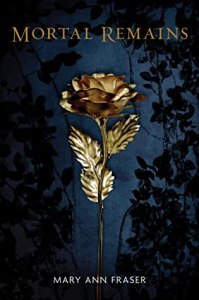 Mortal Remains by Mary Ann Fraser
Mortal Remains by Mary Ann FraserMorticia. Ghoul Girl. Freak. Eighteen-year-old Lily McCrae has heard it all. But despite what the bullies say, she loves her job doing makeup for the dead for her family’s failing funeral home business. Lately, though, Lily’s best friend Mallory is too busy reinventing herself to hang out, her stepbrother Evan is preoccupied with college applications, and her father is pushing her into taking over the family business without even asking her opinion, so she feels lonelier than ever. She finds herself spending all her time in the prep room talking to her “clients.” After all, the dead are the only ones who really listen.
Then the neighboring house is leveled in an explosion, dredging up memories of Adam, the boy who lived there and saved her life the day of the accident that left her scarred and disabled, and of the things she saw there that she just wanted to forget. When she, Mallory, and Evan go exploring and find a mysterious hatch in the rubble, they discover that someone’s been trapped inside. Someone who says his name is Adam. Trouble is, Adam has been missing for four years. And this Adam doesn’t have any memory of her and seems to be keeping a lot of secrets. As she spends more time with him, she can’t help her growing feelings even as his unwillingness to be open leaves her troubled.
Lily is forced to reconcile her feelings for Adam as together they delve into his mysterious past while she also struggles to figure out what she wants out of life and tries to fix her rocky relationships with Mallory and her parents. Will Lily ever decide who she wants to be? And is love enough to overcome truth?
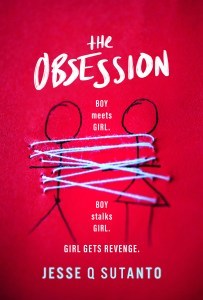 *The Obsession by Jesse Q. Sutanto
*The Obsession by Jesse Q. SutantoNobody knows Delilah like Logan does. Nobody. He makes sure of it by learning everything he can through her social media and watching her through a hidden camera he has trained on her house. Some might call him a stalker. Logan prefers to be called “romantic.”
But after Logan sees Delilah killing her abusive stepfather, he realizes there’s still more about her to discover. His sweet, perfect Delilah isn’t so perfect after all.
Delilah knows she should feel guilty, but all she feels is free. She’s so over the men in her life controlling her. Except Logan saw what she did, and he won’t let her forget it.
Delilah is done being the victim. And she refuses to be a character in Logan’s twisted fantasy. If Logan won’t let her go… she’ll make him.
 A Pho Love Story by Loan Lee
A Pho Love Story by Loan LeeIf Bao Nguyen had to describe himself, he’d say he was a rock. Steady and strong, but not particularly interesting. His grades are average, his social status unremarkable. He works at his parents’ pho restaurant, and even there, he is his parents’ fifth favorite employee. Not ideal.
If Linh Mai had to describe herself, she’d say she was a firecracker. Stable when unlit, but full of potential for joy and fire. She loves art and dreams pursuing a career in it. The only problem? Her parents rely on her in ways they’re not willing to admit, including working practically full-time at her family’s pho restaurant.
For years, the Mais and the Nguyens have been at odds, having owned competing, neighboring pho restaurants. Bao and Linh, who’ve avoided each other for most of their lives, both suspect that the feud stems from feelings much deeper than friendly competition.
But then a chance encounter brings Linh and Bao in the same vicinity despite their best efforts and sparks fly, leading them both to wonder what took so long for them to connect. But then, of course, they immediately remember.
Can Linh and Bao find love in the midst of feuding families and complicated histories?
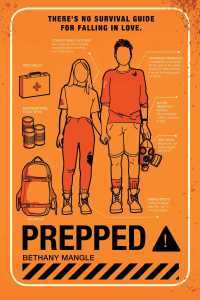 Prepped by Bethany Mangle
Prepped by Bethany MangleAlways be ready for the worst day of your life.
This is the mantra that Becca Aldaine has grown up with. Her family is part of a community of doomsday preppers, a neighborhood that prioritizes survivalist training over class trips or senior prom. They’re even arranging Becca’s marriage with Roy Kang, the only eligible boy in their community. Roy is a nice guy, but he’s so enthusiastic about prepping that Becca doesn’t have the heart to tell him she’s planning to leave as soon as she can earn a full ride to a college far, far away.
Then a devastating accident rocks Becca’s family and pushes the entire community, including Becca’s usually cynical little sister, deeper into the doomsday ideology. With her getaway plans thrown into jeopardy, the only person Becca can turn to is Roy, who reveals that he’s not nearly as clueless as he’s been pretending to be.
When Roy proposes they run away together, Becca will have to risk everything—including her heart—for a chance to hope for the best instead of planning for the worst.
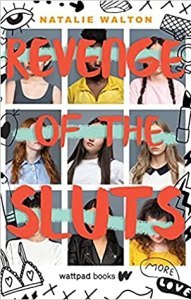 Revenge of the Sluts by Natalie Walton
Revenge of the Sluts by Natalie WaltonDouble standards are about to get singled out.
In this stunning debut, author Natalie Walton tackles privacy and relationships in the digital age.
As a lead reporter for The Warrior Weekly, Eden has covered her fair share of stories at St. Joseph’s High School. And when intimate pictures of seven female students are anonymously emailed to the entire school, Eden is determined to get to the bottom of it.
In tracking down leads, Eden is shocked to discover not everyone agrees the students are victims. Some people feel the girls “brought it on themselves.” Even worse, the school’s administration seems more concerned about protecting its reputation than its students.
With the anonymous sender threatening more emails, Eden finds an unlikely ally: the seven young women themselves. Banding together to find the perpetrator, the tables are about to be turned. The Slut Squad is fighting back!
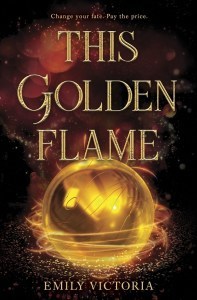 This Golden Flame by Emily Victoria
This Golden Flame by Emily VictoriaOrphaned and forced to serve her country’s ruling group of scribes, Karis wants nothing more than to find her brother, long ago shipped away. But family bonds don’t matter to the Scriptorium, whose sole focus is unlocking the magic of an ancient automaton army.
In her search for her brother, Karis does the seemingly impossible—she awakens a hidden automaton. Intelligent, with a conscience of his own, Alix has no idea why he was made. Or why his father—their nation’s greatest traitor—once tried to destroy the automatons.
Suddenly, the Scriptorium isn’t just trying to control Karis; it’s hunting her. Together with Alix, Karis must find her brother…and the secret that’s held her country in its power for centuries.
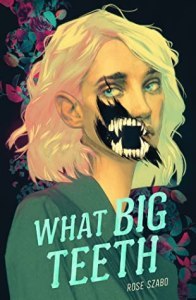 What Big Teeth by Rose Szabo
What Big Teeth by Rose SzaboEleanor Zarrin has been estranged from her wild family for years. When she flees boarding school after a horrifying incident, she goes to the only place she thinks is safe: the home she left behind. But when she gets there, she struggles to fit in with her monstrous relatives, who prowl the woods around the family estate and read fortunes in the guts of birds.
Eleanor finds herself desperately trying to hold the family together — in order to save them all, Eleanor must learn to embrace her family of monsters and tame the darkness inside her.
Exquisitely terrifying, beautiful, and strange, this fierce gothic fantasy will sink its teeth into you and never let go.
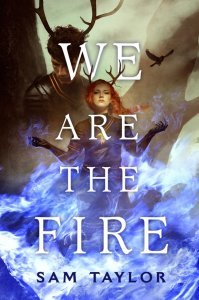 We Are The Fire by Sam Taylor
We Are The Fire by Sam TaylorIn the cold, treacherous land of Vesimaa, children are stolen from their families by a cruel emperor, forced to undergo a horrific transformative procedure, and serve in the army as magical fire-wielding soldiers. Pran and Oksana―both taken from their homeland at a young age―only have each other to hold onto in this heartless place.
Pran dreams of one day rebelling against their oppressors and destroying the empire; Oksana only dreams of returning home and creating a peaceful life for them both.
When they discover the emperor has a new, more terrible mission than ever for their kind, Pran and Oksana vow to escape his tyranny once and for all. But their methods and ideals differ drastically, driving a wedge between them. Worse still, they both soon find that the only way to defeat the monsters that subjugated them may be to become monsters themselves.
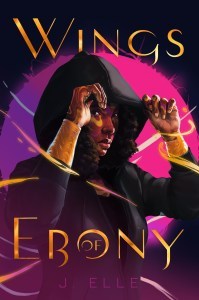 *Wings of Ebony by J. Elle
*Wings of Ebony by J. Elle“Make a way out of no way” is just the way of life for Rue. But when her mother is shot dead on her doorstep, life for her and her younger sister changes forever. Rue’s taken from her neighborhood by the father she never knew, forced to leave her little sister behind, and whisked away to Ghizon—a hidden island of magic wielders.
Rue is the only half-god, half-human there, where leaders protect their magical powers at all costs and thrive on human suffering. Miserable and desperate to see her sister on the anniversary of their mother’s death, Rue breaks Ghizon’s sacred Do Not Leave Law and returns to Houston, only to discover that Black kids are being forced into crime and violence. And her sister, Tasha, is in danger of falling sway to the very forces that claimed their mother’s life.
Worse still, evidence mounts that the evil plaguing East Row is the same one that lurks in Ghizon—an evil that will stop at nothing until it has stolen everything from her and everyone she loves. Rue must embrace her true identity and wield the full magnitude of her ancestors’ power to save her neighborhood before the gods burn it to the ground.
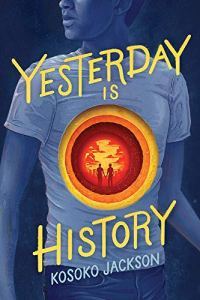 Yesterday Is History by Kosoko Jackson
Yesterday Is History by Kosoko JacksonWeeks ago, Andre Cobb received a much-needed liver transplant.
He’s ready for his life to finally begin, until one night, when he passes out and wakes up somewhere totally unexpected…in 1969, where he connects with a magnetic boy named Michael.
And then, just as suddenly as he arrived, he slips back to present-day Boston, where the family of his donor is waiting to explain that his new liver came with a side effect—the ability to time travel. And they’ve tasked their youngest son, Blake, with teaching Andre how to use his unexpected new gift.
Andre splits his time bouncing between the past and future. Between Michael and Blake. Michael is everything Andre wishes he could be, and Blake, still reeling from the death of his brother, Andre’s donor, keeps him at arm’s length despite their obvious attraction to each other.
Torn between two boys, one in the past and one in the present, Andre has to figure out where he belongs—and more importantly who he wants to be—before the consequences of jumping in time catch up to him and change his future for good.










